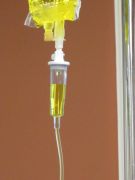Chelation Therapy: Heavy Metal Toxicity – Diagnosis and Treatment
BY: DR. JULIE MILLER
 Diagnosis of heavy metal toxicity is based on symptoms, history of exposure and specialized testing to determine the total body burden of these toxic metals. Because these metals only stay in the blood stream for a very short time before moving into the tissues, testing blood for metals will only indicate an acute exposure.
Diagnosis of heavy metal toxicity is based on symptoms, history of exposure and specialized testing to determine the total body burden of these toxic metals. Because these metals only stay in the blood stream for a very short time before moving into the tissues, testing blood for metals will only indicate an acute exposure.
For most people, it is chronic low-grade exposure and subsequent accumulation over many years that results in metal toxicity issues. The most accurate way to assess total body burden of toxic metals is to do what is termed a provoked urine challenge. This test involves using a substance called a chelating agent to bind to metals that have accumulated in the tissue which are then eliminated through the urine and the feces. Depending on the chelating agent used, it is either given intravenously, as is the case with calcium EDTA and DMPS, or orally using DMSA. Each chelating agent has a certain affinity for the different toxic metals: EDTA is best to pull out lead and aluminum, DMPS had the highest affinity for mercury, and DMSA is the best broad-spectrum chelator. Urine is then collected over a 6 hour period and a sample is send to a specialized lab for analysis . Once the results are received, an individualized treatment program is devised to safely and effective remove these metals from the body.
In addition to using a chelating agent as part of a heavy metal detoxification protocol, it is essential to support the liver and kidneys during this process as they are the organs that are detoxifying these metals and eliminating them from the body. Chlorella, a specialized algae, can also be used to act like a “sponge” in the digestive tract to absorb the toxic metals that are eliminated through the bile and ensure their removal from the body. It is also important to supplement with essential minerals, such as zinc and selenium, because the chelating agents can also pull these from the body as well as the toxic metals.
Research has documented numerous benefits from chelation, especially in the field of cardiovascular disease. Chelation helps to reduce the oxidative damage that initiates plaque build-up in the arteries that leads to hypertension and ischemic heart disease. Current research shows that chelation therapy increases the body’s natural production of nitric oxide in the blood vessel wall. Nitric oxide helps to relax smooth muscles in the arteries allowing for increased delivery of blood, oxygen and other vital nutrients to the tissues. The end result is enhanced circulation, improved kidney function, a reduction in chest pain and blood pressure, and increased exercise tolerance. Improved energy, reduced pain, and better mental clarity are other benefits of heavy metal detoxification. The duration and intensity of chelation therapy is dependent on each individual’s current health status and test results.
